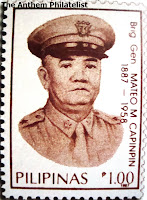Felipe Agoncillo on Stamps

Felipe Agoncillo was an outstanding figure in Philippine diplomacy. He served on the Consultation Board of the Spanish Governor General but was later exiled to Jolo on charges that he was a filibuster, a suspect of revolutionary activities. He escaped and returned to Manila to join the revolution. He later served in several diplomatic posts for the Philippine Commonwealth and the Republic.
Agoncillo was born on May 26, 1859 in Taal, Batangas to Ramon Agoncillo and Gregoria Encarnacion. At an early age, his parents already noticed his brilliant mind. He enrolled at the Ateneo Municipal de Manila where he was a consistent honor high school student and later transferred to the Universidad de Santo Tomás where he obtained his law degree in 1879 with an excellent grade. He was granted a Licentiate in urisprudence with the highest honors. He returned to Taal to manage his family's properties after a year studying in Manila because his parents had both died.
Agoncillo was already a judge and at the age of 30 when he was married to Marcela Mariño, a daughter of a reputed family in the same town. Six daughters were born to them: Lorenza (Enchang), Gregoria (Goring), Eugenia (Nene), Marcela (Celing)—named after her mother because they thought she will be their last child, Adela, who died at the age of three and the youngest Maria (Maring), who was their last child to survive and died on July 6, 1995.
While in Taal, Agoncillo continued his legal services and gave charity to poor and oppressed Filipinos. He was so generous that he posted an inscription outside his office: "Free legal services to the poor anytime."
Having heard by the parish priest of his activities and for preaching patriotic ideas, he was accused as anti patriotic, anti religious and was described as filibustero or subversive. He was later recommended to the governor-general for deportation.
Forewarned by the plans of the governor-general, he sailed directly to Yokohama, Japan but briefly stayed and went to Hong Kong where he joined other Filipino exiles who found asylum when the revolution broke out in 1896. They temporarily sojourned at Morrison Hill Road in Wanchai and later became a refuge for exiled Filipino patriots.
When the signing of the Pact of Biak-na-Bato concluded, Gen. Aguinaldo joined to them. They initiated meetings in the Agoncillo residence on the months of April and March 1898 and Gen. Luna was one in the attendance.
After the signing of the truce, Agoncillo spearheaded the Central Revolutionary Committee and organized the propaganda office for General Aguinaldo's revolutionary government.
The Philippine Revolutionary Government commissioned Agoncillo as Minister Plenipotentiary to negotiate treaties with foreign governments. Agoncillo and Jose "Sixto" Lopez was sent to Washington, D.C., United States to lobby foreign entities that Filipinos are well civilized people and capable of maintaining stable government and to secure recognition of Philippine independence but US President William McKinley did not receive them. To gather sympathy to the Philippine cause, they addressed the American Episcopalian bishops.
After being ignored by the US president, Agoncillo proceeded to Paris, France to present the Philippine cause at the peace conference convened between Spain and the US, where a meeting was to be held to discuss Cuba and the Philippines. Agoncillo tried to submit a memorandum but again failed. The people behind the meeting did not want to have any official dealings with him. On December 10, 1898, the treaty was successfully signed. Subsequently, Agoncillo's diplomatic activity incurred sum of money that he had used up all his savings going from one country to another presenting the case of the Philippines that he had even sacrificed his wife's jewelry.
Two days after the signing of the Treaty of Paris, Agoncillo returned to the United States and endeavored to block ratification of the treaty by the US. Although this was signed by the commissioners, it was not yet approved by the Senate of the United States. He filed a State memorandum to express that Filipinos must be recognized by the United States.
Agoncillo's conclusion about the treaty was that it was not binding on the Philippine government. In the memorandum, he clearly stated the reasons why Spain had no right to transfer the Philippines to the United States and that when the treaty was signed, Spain no longer held the Filipinos. At that time, many Americans were also against the treaty, so they established the Anti-Imperialist League which opposed making the Philippines a colony of the United States. Afterwards, on February 4, 1899, the Philippine–American War began; this turned on approval of the treaty of Paris.
On August 29, 1900, he met with Gustave Moynier, an original member of the Committee of Five and ICRC President. Agoncillo sought recognition of the Filipino Red Cross Society as well as the application of the First Geneva Convention during the Philippine–American War.
When hostilities ended between Filipinos and Americans, he returned to Hong Kong and rejoined the exiled junta. Later, on July 15, 1901, after American rule was firmly established in Manila,he went back to the Philippines as a poor man and lived in his house in Malate, Manila together with his family.
While in Manila, he resumed his law practice and other business. He took the bar exam in 1905 and passed with a perfect score of 100 percent, an achievement which has remained unmatched until today. His examination papers have been preserved in the Filipiniana section of the Philippine Library and Museum.
In 1907, he was elected as the Batangas representative and represented that town, among others, in the Philippine Assembly. He was once a defense of El Renacimiento whose editors were charged with libel by Dean C. Worcester. De Agoncillo was appointed as Secretary of Interior in 1923 during the administration of Governor General Leonard Wood and fought for the Filipinization of the government service. Agoncillo died on September 29, 1941 in Manila Doctor's Hospital, Manila.
The stamp above was issued on February 27, 1976.






